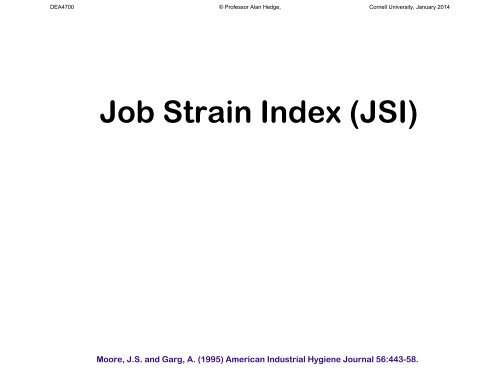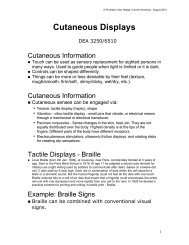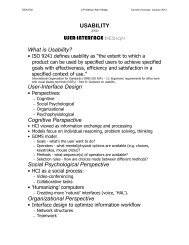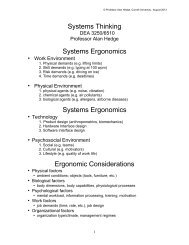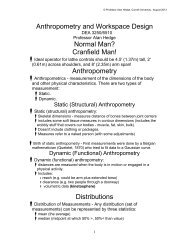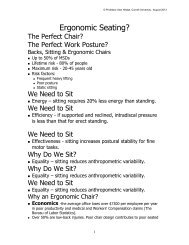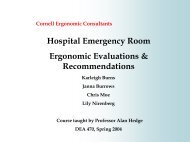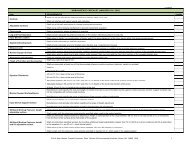JSI, REBA, RULA - Cornell University Ergonomics Web
JSI, REBA, RULA - Cornell University Ergonomics Web
JSI, REBA, RULA - Cornell University Ergonomics Web
Create successful ePaper yourself
Turn your PDF publications into a flip-book with our unique Google optimized e-Paper software.
DEA4700 © Professor Alan Hedge, <strong>Cornell</strong> <strong>University</strong>, January 2014<br />
Job Strain Index (<strong>JSI</strong>)<br />
Moore, J.S. and Garg, A. (1995) American Industrial Hygiene Journal 56:443-58.
DEA4700 © Professor Alan Hedge, <strong>Cornell</strong> <strong>University</strong>, January 2014<br />
<strong>JSI</strong> Ratings<br />
1. Intensity of Exertion<br />
2. Duration of Exertion<br />
3. Efforts per Minute<br />
4. Hand/Wrist Posture<br />
5. Speed of Work<br />
6. Duration of Task per Day<br />
Moore, J.S. and Garg, A. (1995) American Industrial Hygiene Journal 56:443-58.
DEA4700 © Professor Alan Hedge, <strong>Cornell</strong> <strong>University</strong>, January 2014<br />
1. Intensity of Exertion<br />
An estimate of the strength required to perform the task one time. Guidelines<br />
for assigning a rating criterion are presented in the following table.<br />
Rating Criterion % MS A Scale<br />
Borg<br />
B<br />
Perceived Effort<br />
Light 7 uses shoulder or trunk to generate force<br />
APercentage of maximal strength<br />
BCompared to the Borg CR-10scale (76)<br />
Moore, J.S. and Garg, A. (1995) American Industrial Hygiene Journal 56:443-58.
DEA4700 © Professor Alan Hedge, <strong>Cornell</strong> <strong>University</strong>, January 2014<br />
2. Duration of Exertion<br />
Duration of Exertion is calculated by measuring the duration of all<br />
exertions during an observation period, then dividing the measured<br />
duration of exertion by the total observation time and multiplying by<br />
100.<br />
% Duration of Exertion = 100 x duration of all exertions (sec)<br />
total observation time (sec)<br />
Moore, J.S. and Garg, A. (1995) American Industrial Hygiene Journal 56:443-58.
DEA4700 © Professor Alan Hedge, <strong>Cornell</strong> <strong>University</strong>, January 2014<br />
3. Efforts per Minute<br />
Efforts per Minute are measured by counting the number of<br />
exertions that occur during an observation period, then<br />
dividing the number of exertions by the duration of the<br />
observation period, measured in minutes.<br />
Efforts per Minute =<br />
number of exertions<br />
total observation time (min)<br />
Moore, J.S. and Garg, A. (1995) American Industrial Hygiene Journal 56:443-58.
DEA4700 © Professor Alan Hedge, <strong>Cornell</strong> <strong>University</strong>, January 2014<br />
4. Hand/Wrist Posture<br />
Hand/Wrist Posture is an estimate of the position of the hand<br />
or wrist relative to neutral position. Guidelines for assigning a<br />
rating criterion are presented in the following table.<br />
Rating Criterion Wrist Extension A Wrist<br />
Flexion A<br />
Ulnar<br />
Deviation<br />
A<br />
Perceived Posture<br />
Very Good 0 o -10 o 0 o -5 o 0 o -10 o perfectly neutral<br />
Good 11 o -25 o 6 o -15 o 11 o -15 o near neutral<br />
Fair 26 o -40 o 16 o -30 o 16 o -20 o nonneutral<br />
Bad 41 o -55 o 31 o -50 o 21 o -25 o marked deviation<br />
Very Bad >60 o >50 o >25 o near extreme<br />
A<br />
From derived from data.<br />
Moore, J.S. and Garg, A. (1995) American Industrial Hygiene Journal 56:443-58.
DEA4700 © Professor Alan Hedge, <strong>Cornell</strong> <strong>University</strong>, January 2014<br />
5. Speed of Work<br />
Speed of Work is an estimate of how fast the worker is working.<br />
Guidelines for assigning a rating criterion are presented in the<br />
following table.<br />
Rating Criterion Compared to MTM-1 A Perceived Speed<br />
Very Slow 115% rushed and barely or unable to keep up<br />
A The observed pace is divided by MTM-1's predicted pace and expressed as a percentage of predicted.<br />
Moore, J.S. and Garg, A. (1995) American Industrial Hygiene Journal 56:443-58.
DEA4700 © Professor Alan Hedge, <strong>Cornell</strong> <strong>University</strong>, January 2014<br />
6. Duration of Task per Day<br />
Duration of Task per Day is either measured or obtained<br />
from plant personnel.<br />
Moore, J.S. and Garg, A. (1995) American Industrial Hygiene Journal 56:443-58.
DEA4700 © Professor Alan Hedge, <strong>Cornell</strong> <strong>University</strong>, January 2014<br />
Job Stress Index<br />
Rating<br />
Intensity of<br />
Exertion<br />
(IE)<br />
Duration of<br />
Exertion<br />
(DE)<br />
Efforts/<br />
Minute<br />
(EM)<br />
Hand/Wrist<br />
Posture<br />
(HWP)<br />
Speed of<br />
Work<br />
(SW)<br />
Duration per<br />
Day<br />
(DD)<br />
1<br />
Light<br />
DEA4700 © Professor Alan Hedge, <strong>Cornell</strong> <strong>University</strong>, January 2014<br />
Job Stress Index Worksheet<br />
Intensity<br />
of<br />
Exertion<br />
(IE)<br />
Duration of<br />
Exertion<br />
(DE)<br />
Efforts/<br />
Minute<br />
(EM)<br />
Hand/Wrist<br />
Posture<br />
(HWP)<br />
Speed of<br />
Work<br />
(SW)<br />
Duration per<br />
Day<br />
(DD)<br />
Exposure<br />
data<br />
Ratings<br />
Multipliers<br />
SI Scores<br />
<strong>JSI</strong><br />
= IE x DE x EM x HWP x SW x DD<br />
Moore, J.S. and Garg, A. (1995) American Industrial Hygiene Journal 56:443-58.
DEA4700 © Professor Alan Hedge, <strong>Cornell</strong> <strong>University</strong>, January 2014<br />
Job Stress Index Worksheet<br />
Example<br />
Intensity<br />
of<br />
Exertion<br />
(IE)<br />
Duration<br />
of<br />
Exertion<br />
(DE)<br />
Efforts/<br />
Minute<br />
(EM)<br />
Hand/Wrist<br />
Posture<br />
(HWP)<br />
Speed of<br />
Work<br />
(SW)<br />
Duration per<br />
Day<br />
(DD)<br />
Exposure<br />
data<br />
Somewhat<br />
hard<br />
60%<br />
12<br />
fair<br />
fair<br />
4-8<br />
Ratings<br />
2<br />
4<br />
3<br />
3<br />
3<br />
4<br />
Multipliers<br />
3.0<br />
2.0<br />
1.5<br />
1.5<br />
1.0<br />
1.0<br />
<strong>JSI</strong><br />
= IE x DE x EM x HWP x SW x DD<br />
<strong>JSI</strong> = 3.0 x 2.0 x 1.5 x 1.5 x 1.0 x 1.0<br />
<strong>JSI</strong> = 13.5<br />
Moore, J.S. and Garg, A. (1995) American Industrial Hygiene Journal 56:443-58.
DEA4700 © Professor Alan Hedge, <strong>Cornell</strong> <strong>University</strong>, January 2014<br />
Job Strain Index<br />
• Preliminary testing has revealed that jobs<br />
associated with distal upper extremity disorders<br />
had SI Scores greater than 5.<br />
• SI Scores less than or equal to 3 are probably<br />
safe.<br />
• SI Scores greater than or equal to 7 are probably<br />
hazardous.<br />
• The Strain Index does not consider stresses<br />
related to localized mechanical compression.<br />
This risk factor should be considered separately.<br />
Moore, J.S. and Garg, A. (1995) American Industrial Hygiene Journal 56:443-58.
DEA4700 © Professor Alan Hedge, <strong>Cornell</strong> <strong>University</strong>, January 2014<br />
<strong>JSI</strong>: Sensitivity Analysis<br />
Mean Incidence Rate<br />
140<br />
120<br />
100<br />
80<br />
60<br />
40<br />
20<br />
0<br />
60<br />
Mean Incidence Rate = # MSD injuries/100 workers/Year<br />
Moore, J.S. and Garg, A. (1995) American Industrial Hygiene Journal 56:443-58.
DEA4700 © Professor Alan Hedge, <strong>Cornell</strong> <strong>University</strong>, January 2014<br />
Rapid Entire Body<br />
Assessment:<br />
(<strong>REBA</strong>)<br />
Source: Hignett, S., McAtamney, L. (2000) Applied <strong>Ergonomics</strong>, 31, 201-5.
DEA4700 © Professor Alan Hedge, <strong>Cornell</strong> <strong>University</strong>, January 2014<br />
<strong>REBA</strong>: Trunk Score<br />
1<br />
0 o 20 o 60 o<br />
Change<br />
Movement Score<br />
2 2<br />
Score<br />
Upright<br />
0 o -20 o flexion<br />
0 o -20 o extension 2 +1 if<br />
20 o -60 o flexion<br />
twisting<br />
>20 o extension<br />
or side<br />
3 flexed<br />
>60 o flexion<br />
1<br />
4<br />
20 o<br />
3 3<br />
4<br />
Source: Hignett, S., McAtamney, L. (2000) Applied <strong>Ergonomics</strong>, 31, 201-5.
DEA4700 © Professor Alan Hedge, <strong>Cornell</strong> <strong>University</strong>, January 2014<br />
<strong>REBA</strong>: Neck Score<br />
Movement<br />
0 o -20 o flexion<br />
Score<br />
1<br />
Change<br />
score:<br />
0 o<br />
20 o 1 1<br />
20 o<br />
>20 o flexion<br />
or<br />
>20 o extension<br />
2<br />
+1 if<br />
twisting or<br />
side flexed<br />
2 2<br />
Source: Hignett, S., McAtamney, L. (2000) Applied <strong>Ergonomics</strong>, 31, 201-5.
DEA4700 © Professor Alan Hedge, <strong>Cornell</strong> <strong>University</strong>, January 2014<br />
<strong>REBA</strong>: Legs Score<br />
1 2<br />
Position<br />
Score<br />
Change score<br />
Bilateral weight<br />
bearing, walking or<br />
sitting<br />
1<br />
+1 if knees<br />
between 30 o -<br />
60 o flexion<br />
Unilateral weight<br />
bearing<br />
Feather weight<br />
bearing or an unstable<br />
posture<br />
2<br />
+2 if knees<br />
>60 o flexion<br />
(n.b. Not for<br />
sitting)<br />
+1 +2<br />
30 o -60 o >60 o<br />
Source: Hignett, S., McAtamney, L. (2000) Applied <strong>Ergonomics</strong>, 31, 201-5.
DEA4700 © Professor Alan Hedge, <strong>Cornell</strong> <strong>University</strong>, January 2014<br />
<strong>REBA</strong>: Upper Arms<br />
Position<br />
Score<br />
Change score<br />
4<br />
90 o<br />
20 o extension to 20 o<br />
flexion<br />
>20 o extension<br />
20 o -45 o flexion<br />
45 o -90 o flexion<br />
>90 o flexion<br />
1<br />
2<br />
3<br />
4<br />
+1 if arm is<br />
abducted or<br />
rotated<br />
+1 if shoulder<br />
is raised<br />
-1 if leaning,<br />
supporting<br />
weight of arm<br />
or if posture is<br />
gravity<br />
assisted<br />
2 2<br />
1<br />
0 o<br />
1<br />
20 o 20 o<br />
3<br />
45 o<br />
Source: Hignett, S., McAtamney, L. (2000) Applied <strong>Ergonomics</strong>, 31, 201-5.
DEA4700 © Professor Alan Hedge, <strong>Cornell</strong> <strong>University</strong>, January 2014<br />
<strong>REBA</strong>: Lower arms<br />
Movement Score<br />
2<br />
100 o<br />
60 o - 100 o flexion<br />
1<br />
100 o flexion<br />
2<br />
2<br />
1<br />
60 o<br />
0 o<br />
Source: Hignett, S., McAtamney, L. (2000) Applied <strong>Ergonomics</strong>, 31, 201-5.
DEA4700 © Professor Alan Hedge, <strong>Cornell</strong> <strong>University</strong>, January 2014<br />
<strong>REBA</strong>: Wrists<br />
Movement<br />
Score<br />
Change<br />
score:<br />
2<br />
0 o -15 o flexion or<br />
extension<br />
>15 o flexion<br />
or<br />
> 15 o extension<br />
1<br />
2<br />
+1 if wrist is<br />
deviated or<br />
twisted<br />
2<br />
15 o 0 o 1<br />
15 o<br />
1<br />
Source: Hignett, S., McAtamney, L. (2000) Applied <strong>Ergonomics</strong>, 31, 201-5.
Group<br />
A<br />
DEA4700 © Professor Alan Hedge, <strong>Cornell</strong> <strong>University</strong>, January 2014<br />
<strong>REBA</strong>: Scoring L R<br />
Trunk<br />
Neck<br />
Legs<br />
Use Table A<br />
Use Table B<br />
+ +<br />
Load/Force<br />
Coupling<br />
L<br />
Upper arms<br />
Lower arms<br />
L<br />
Wrists<br />
R<br />
R<br />
Group<br />
B<br />
Score A<br />
Use Table C<br />
Score B<br />
Score C<br />
Activity<br />
Score<br />
+<br />
<strong>REBA</strong> Score<br />
Source: Hignett, S., McAtamney, L. (2000) Applied <strong>Ergonomics</strong>, 31, 201-5.
DEA4700 © Professor Alan Hedge, <strong>Cornell</strong> <strong>University</strong>, January 2014<br />
Table A and Load<br />
Neck<br />
Trunk<br />
1<br />
2<br />
3<br />
Legs<br />
1<br />
2<br />
3<br />
4<br />
1<br />
2<br />
3<br />
4<br />
1<br />
2<br />
3<br />
4<br />
1<br />
1<br />
2<br />
3<br />
4<br />
1<br />
2<br />
3<br />
4<br />
3<br />
3<br />
5<br />
6<br />
2<br />
2<br />
3<br />
4<br />
5<br />
3<br />
4<br />
5<br />
6<br />
4<br />
5<br />
6<br />
7<br />
3<br />
2<br />
4<br />
5<br />
6<br />
4<br />
5<br />
6<br />
7<br />
5<br />
6<br />
7<br />
8<br />
4<br />
3<br />
5<br />
6<br />
7<br />
5<br />
6<br />
7<br />
8<br />
6<br />
7<br />
8<br />
9<br />
5<br />
4<br />
6<br />
7<br />
8<br />
6<br />
7<br />
8<br />
9<br />
7<br />
8<br />
9<br />
9<br />
Load/Force<br />
0<br />
1<br />
2<br />
+1<br />
< 10 lb<br />
(20 lb<br />
(>10 kg)<br />
Shock or rapid build<br />
up of force<br />
Source: Hignett, S., McAtamney, L. (2000) Applied <strong>Ergonomics</strong>, 31, 201-5.
DEA4700 © Professor Alan Hedge, <strong>Cornell</strong> <strong>University</strong>, January 2014<br />
<strong>REBA</strong>: Table B and Coupling<br />
Lower arm<br />
Upper arm<br />
1<br />
2<br />
Wrist<br />
1<br />
2<br />
3<br />
1<br />
2<br />
3<br />
1<br />
1<br />
2<br />
3<br />
1<br />
2<br />
3<br />
2<br />
1<br />
2<br />
3<br />
2<br />
3<br />
4<br />
3<br />
3<br />
4<br />
5<br />
4<br />
5<br />
5<br />
4<br />
4<br />
5<br />
5<br />
5<br />
6<br />
7<br />
5<br />
6<br />
7<br />
8<br />
7<br />
8<br />
8<br />
6<br />
7<br />
8<br />
8<br />
8<br />
9<br />
9<br />
Coupling<br />
0 - Good<br />
1 - Fair<br />
2 - Poor<br />
3 - Unacceptable<br />
Well-fitted handle with a midrange<br />
power grip<br />
Hand hold acceptable but not<br />
ideal or coupling is acceptable<br />
via another part of the body<br />
Hand hold not<br />
acceptable although<br />
possible<br />
Awkward, unsafe grip, no<br />
handles.<br />
Coupling is unacceptable using<br />
other parts of the body<br />
Source: Hignett, S., McAtamney, L. (2000) Applied <strong>Ergonomics</strong>, 31, 201-5.
Score<br />
A<br />
DEA4700 © Professor Alan Hedge, <strong>Cornell</strong> <strong>University</strong>, January 2014<br />
<strong>REBA</strong>: Table C and Activity Score<br />
1<br />
2<br />
3<br />
4<br />
5<br />
6<br />
7<br />
8<br />
9<br />
10<br />
11<br />
12<br />
10<br />
11<br />
12<br />
10<br />
11<br />
12<br />
+1 = 1 or more body parts are static,<br />
e.g. held for longer than 1 minute<br />
1<br />
1<br />
1<br />
2<br />
3<br />
4<br />
6<br />
7<br />
8<br />
9<br />
2<br />
1<br />
2<br />
3<br />
4<br />
4<br />
6<br />
7<br />
8<br />
9<br />
3<br />
1<br />
2<br />
3<br />
4<br />
4<br />
6<br />
7<br />
8<br />
9<br />
10<br />
11<br />
12<br />
4<br />
2<br />
3<br />
3<br />
4<br />
5<br />
7<br />
8<br />
9<br />
10<br />
11<br />
11<br />
12<br />
10<br />
10<br />
11<br />
12<br />
12<br />
Score B<br />
Activity Score<br />
10<br />
10<br />
11<br />
12<br />
12<br />
+1 = repeated small range actions, e.g.<br />
repeated more than 4 times per minute<br />
(excluding walking)<br />
5<br />
3<br />
4<br />
4<br />
5<br />
6<br />
8<br />
9<br />
6<br />
3<br />
4<br />
5<br />
6<br />
7<br />
8<br />
9<br />
7<br />
4<br />
5<br />
6<br />
7<br />
8<br />
9<br />
9<br />
10<br />
11<br />
11<br />
12<br />
12<br />
8<br />
5<br />
6<br />
7<br />
8<br />
8<br />
9<br />
10<br />
10<br />
11<br />
12<br />
12<br />
12<br />
9<br />
6<br />
6<br />
7<br />
8<br />
9<br />
10<br />
10<br />
10<br />
11<br />
12<br />
12<br />
12<br />
10<br />
10<br />
11<br />
11<br />
12<br />
12<br />
12<br />
12<br />
10<br />
11<br />
11<br />
12<br />
12<br />
12<br />
12<br />
+1 = action causes rapid large range<br />
changes in posture or an unstable<br />
base<br />
7<br />
7<br />
8<br />
9<br />
9<br />
11<br />
7<br />
7<br />
8<br />
9<br />
9<br />
Source: Hignett, S., McAtamney, L. (2000) Applied <strong>Ergonomics</strong>, 31, 201-5.
DEA4700 © Professor Alan Hedge, <strong>Cornell</strong> <strong>University</strong>, January 2014<br />
<strong>REBA</strong>: Action Levels<br />
Action level<br />
<strong>REBA</strong> score<br />
Risk level<br />
Action<br />
(including further assessment)<br />
0<br />
1<br />
Negligible<br />
None necessary<br />
1<br />
2-3<br />
Low<br />
May be necessary<br />
2<br />
4-7<br />
Medium<br />
Necessary<br />
3<br />
8-10<br />
High<br />
Necessary soon<br />
4<br />
11-15<br />
Very high<br />
Necessary NOW<br />
Source: Hignett, S., McAtamney, L. (2000) Applied <strong>Ergonomics</strong>, 31, 201-5.
DEA4700 © Professor Alan Hedge, <strong>Cornell</strong> <strong>University</strong>, January 2014<br />
Rapid Upper Limb<br />
Assessment (<strong>RULA</strong>)<br />
Method<br />
<strong>RULA</strong> Source: McAtamney, L. and Corlett, E.N. (1993) Applied <strong>Ergonomics</strong>, 24 (2), 91-9.
DEA4700 © Professor Alan Hedge, <strong>Cornell</strong> <strong>University</strong>, January 2014<br />
What is <strong>RULA</strong><br />
• <strong>RULA</strong> is a quick survey method for use in ergonomic<br />
investigations of workplaces where MSDs are reported.<br />
• <strong>RULA</strong> is a screening tool that assesses biomechanical and<br />
postural loading on the whole body.<br />
• <strong>RULA</strong> focuses on the neck, trunk and upper limbs, and is<br />
ideal for sedentary workers e.g. computer workplaces.<br />
• <strong>RULA</strong> has been validated on groups of computer users and<br />
sewing machine operators.<br />
• <strong>RULA</strong> is quick and easy to complete.<br />
• <strong>RULA</strong> scores indicate the level of intervention required to<br />
reduce MSD risks.<br />
• <strong>RULA</strong> compliments other ergonomic methods.
DEA4700 © Professor Alan Hedge, <strong>Cornell</strong> <strong>University</strong>, January 2014<br />
1. Observing and selecting the<br />
posture(s) to assess<br />
• <strong>RULA</strong> assesses postural loading at a specific moment in the work<br />
cycle. It is important to assess the highest risk posture being<br />
adopted. Selecting the appropriate stage of the work cycle for<br />
assessment requires some previous observation.<br />
• The highest risk posture for analysis may be chosen based on the<br />
duration of the posture (e.g. longest held) or the degree of<br />
postural deviation (e.g. worst posture).<br />
• Right or left sides of the body can be assessed independently.<br />
• For long work cycles posture can be assessed at regular<br />
intervals.<br />
• When assessments are taken at set intervals over the working<br />
period the proportion of time spent in the various postures<br />
should also be evaluated.
DEA4700 © Professor Alan Hedge, <strong>Cornell</strong> <strong>University</strong>, January 2014<br />
2. Scoring and recording the posture<br />
• Decide on the stage of the work cycle to be assessed<br />
• Decide whether the left, right or both upper arms are to be<br />
assessed.<br />
• Score the posture of each body part using the <strong>RULA</strong><br />
worksheet.<br />
• Review the scoring and make any adjustments if required.<br />
• Use the tables to calculate the grand <strong>RULA</strong> score.
DEA4700 © Professor Alan Hedge, <strong>Cornell</strong> <strong>University</strong>, January 2014<br />
3. Action Level<br />
• Compare the grand <strong>RULA</strong> score to the Action Level List to<br />
determine the risks.<br />
• Review the body segment scores for any undesirable<br />
postural deviations that need correction.<br />
• Review possibilities for further ergonomic actions to improve<br />
posture where necessary, and thereby reduce risks.<br />
• If changes are made, evaluate their success by performing<br />
additional <strong>RULA</strong> evaluations.
DEA4700 © Professor Alan Hedge, <strong>Cornell</strong> <strong>University</strong>, January 2014<br />
<strong>RULA</strong>: Upper Arms<br />
ADD 1 if:<br />
– Shoulder is raised<br />
ADD 1 if:<br />
– Upper arm is abducted<br />
SUBTRACT 1<br />
– If leaning or supporting the weight of the arm<br />
<strong>RULA</strong> Source: McAtamney, L. and Corlett, E.N. (1993) Applied <strong>Ergonomics</strong>, 24 (2), 91-9.<br />
Graphics source: K. Laeser, 1998, <strong>Cornell</strong> <strong>University</strong>
DEA4700 © Professor Alan Hedge, <strong>Cornell</strong> <strong>University</strong>, January 2014<br />
<strong>RULA</strong>: Lower Arms<br />
ADD 1 if:<br />
– Working across midline<br />
of the body<br />
– Working out to the side of<br />
the body<br />
<strong>RULA</strong> Source: McAtamney, L. and Corlett, E.N. (1993) Applied <strong>Ergonomics</strong>, 24 (2), 91-9.<br />
Graphics source: K. Laeser, 1998, <strong>Cornell</strong> <strong>University</strong>
DEA4700 © Professor Alan Hedge, <strong>Cornell</strong> <strong>University</strong>, January 2014<br />
<strong>RULA</strong>: Wrist posture<br />
ADD 1 if:<br />
– Wrist is<br />
bent away<br />
from<br />
midline<br />
<strong>RULA</strong> Source: McAtamney, L. and Corlett, E.N. (1993) Applied <strong>Ergonomics</strong>, 24 (2), 91-9.<br />
Graphics source: K. Laeser, 1998, <strong>Cornell</strong> <strong>University</strong>
DEA4700 © Professor Alan Hedge, <strong>Cornell</strong> <strong>University</strong>, January 2014<br />
<strong>RULA</strong>: Wrist Twist<br />
1. Mainly in mid-range of twist<br />
2. At or near end of twisting range<br />
<strong>RULA</strong> Source: McAtamney, L. and Corlett, E.N. (1993) Applied <strong>Ergonomics</strong>, 24 (2), 91-9.
DEA4700 © Professor Alan Hedge, <strong>Cornell</strong> <strong>University</strong>, January 2014<br />
<strong>RULA</strong>: Neck<br />
ADD 1 if:<br />
– Neck is twisting<br />
ADD 1 if:<br />
– Neck is side-bending<br />
<strong>RULA</strong> Source: McAtamney, L. and Corlett, E.N. (1993) Applied <strong>Ergonomics</strong>, 24 (2), 91-9.<br />
Graphics source: K. Laeser, 1998, <strong>Cornell</strong> <strong>University</strong>
DEA4700 © Professor Alan Hedge, <strong>Cornell</strong> <strong>University</strong>, January 2014<br />
<strong>RULA</strong>: Trunk<br />
ADD 1 if:<br />
– Trunk is twisting<br />
ADD 1 if:<br />
– Trunk is side-bending<br />
<strong>RULA</strong> Source: McAtamney, L. and Corlett, E.N. (1993) Applied <strong>Ergonomics</strong>, 24 (2), 91-9.<br />
Graphics source: K. Laeser, 1998, <strong>Cornell</strong> <strong>University</strong>
DEA4700 © Professor Alan Hedge, <strong>Cornell</strong> <strong>University</strong>, January 2014<br />
<strong>RULA</strong>: Legs<br />
1. Legs and feet are well supported and in<br />
an evenly balanced posture.<br />
2. Legs and feet are NOT well supported<br />
and/or NOT in an evenly balanced<br />
posture.<br />
<strong>RULA</strong> Source: McAtamney, L. and Corlett, E.N. (1993) Applied <strong>Ergonomics</strong>, 24 (2), 91-9.
DEA4700 © Professor Alan Hedge, <strong>Cornell</strong> <strong>University</strong>, January 2014<br />
<strong>RULA</strong>: Muscle Use Score<br />
• RAISE THE SCORE by 1 if the posture is:<br />
– Mainly static, e.g. held for longer than 1 minute<br />
– Repeated more than 4 times per minute<br />
<strong>RULA</strong> Source: McAtamney, L. and Corlett, E.N. (1993) Applied <strong>Ergonomics</strong>, 24 (2), 91-9.
DEA4700 © Professor Alan Hedge, <strong>Cornell</strong> <strong>University</strong>, January 2014<br />
<strong>RULA</strong>: FORCES or LOAD Score<br />
0.<br />
1.<br />
2.<br />
3.<br />
No resistance<br />
or less than 5<br />
lb. (2 kg)<br />
intermittent<br />
load force<br />
5-20 lb (2-10<br />
kg)<br />
intermittent<br />
load or force<br />
5-20 lb (2-10<br />
kg) static or<br />
repeated load<br />
or force<br />
More than 20<br />
lb. (10kg)<br />
static or<br />
repeated<br />
loads or<br />
forces.<br />
Shock or<br />
forces with<br />
rapid build-up.<br />
<strong>RULA</strong> Source: McAtamney, L. and Corlett, E.N. (1993) Applied <strong>Ergonomics</strong>, 24 (2), 91-9.
A<br />
DEA4700<br />
<strong>RULA</strong><br />
© Professor<br />
Score<br />
Alan Hedge,<br />
Sheet<br />
<strong>Cornell</strong> <strong>University</strong>, January 2014<br />
Upper arm<br />
Lower arm<br />
Wrist<br />
Posture<br />
score<br />
A<br />
Muscle use<br />
Force<br />
+ + =<br />
SCORE A<br />
Wrist twist<br />
Neck<br />
Posture<br />
score<br />
A<br />
Muscle use<br />
Grand<br />
Score<br />
Use Table C<br />
Force<br />
SCORE B<br />
B<br />
Trunk<br />
Legs<br />
+ + =<br />
<strong>RULA</strong> Source: McAtamney, L. and Corlett, E.N. (1993) Applied <strong>Ergonomics</strong>, 24 (2), 91-9.<br />
Graphics source: K. Laeser, 1998, <strong>Cornell</strong> <strong>University</strong>
DEA4700 © Professor Alan Hedge, <strong>Cornell</strong> <strong>University</strong>, January 2014<br />
Table A: Upper Limb Posture Score<br />
WRIST<br />
UPPER<br />
ARM<br />
LOWER<br />
ARM<br />
1<br />
WRIST TWIST<br />
2<br />
WRIST TWIST<br />
3<br />
WRIST TWIST<br />
4<br />
WRIST TWIST<br />
1<br />
2<br />
1<br />
2<br />
1<br />
2<br />
1<br />
2<br />
1<br />
1<br />
2<br />
2<br />
2<br />
2<br />
3<br />
3<br />
3<br />
1<br />
2<br />
2<br />
2<br />
2<br />
2<br />
3<br />
3<br />
3<br />
3<br />
3<br />
2<br />
3<br />
2<br />
3<br />
3<br />
3<br />
4<br />
4<br />
1<br />
2<br />
2<br />
2<br />
3<br />
3<br />
3<br />
4<br />
4<br />
2<br />
2<br />
2<br />
2<br />
2<br />
3<br />
3<br />
3<br />
4<br />
4<br />
3<br />
2<br />
3<br />
3<br />
3<br />
3<br />
4<br />
4<br />
5<br />
1<br />
2<br />
3<br />
3<br />
3<br />
4<br />
4<br />
5<br />
5<br />
3<br />
2<br />
2<br />
3<br />
3<br />
3<br />
4<br />
4<br />
5<br />
5<br />
3<br />
2<br />
3<br />
3<br />
4<br />
4<br />
4<br />
5<br />
5<br />
1<br />
3<br />
4<br />
4<br />
4<br />
4<br />
4<br />
5<br />
5<br />
4<br />
2<br />
3<br />
4<br />
4<br />
4<br />
4<br />
4<br />
5<br />
5<br />
3<br />
3<br />
4<br />
4<br />
5<br />
5<br />
5<br />
6<br />
6<br />
1<br />
5<br />
5<br />
5<br />
5<br />
5<br />
6<br />
6<br />
7<br />
5<br />
2<br />
5<br />
6<br />
6<br />
6<br />
6<br />
7<br />
7<br />
7<br />
3<br />
6<br />
6<br />
6<br />
7<br />
7<br />
7<br />
7<br />
8<br />
1<br />
7<br />
7<br />
7<br />
7<br />
7<br />
8<br />
8<br />
9<br />
6<br />
2<br />
7<br />
8<br />
8<br />
8<br />
8<br />
9<br />
9<br />
9<br />
3<br />
9<br />
9<br />
9<br />
9<br />
9<br />
9<br />
9<br />
9<br />
<strong>RULA</strong> Source: McAtamney, L. and Corlett, E.N. (1993) Applied <strong>Ergonomics</strong>, 24 (2), 91-9.
DEA4700 © Professor Alan Hedge, <strong>Cornell</strong> <strong>University</strong>, January 2014<br />
Table B: Neck, Trunk, Legs Posture Score<br />
TRUNK POSTURE SCORE<br />
NECK<br />
POSTURE<br />
SCORE<br />
1<br />
LEGS<br />
2<br />
LEGS<br />
3<br />
LEGS<br />
4<br />
LEGS<br />
5<br />
LEGS<br />
6<br />
LEGS<br />
1<br />
2<br />
1<br />
2<br />
1<br />
2<br />
1<br />
2<br />
1<br />
2<br />
1<br />
2<br />
1<br />
1<br />
2<br />
1<br />
2<br />
2<br />
3<br />
3<br />
4<br />
4<br />
4<br />
4<br />
4<br />
2<br />
1<br />
2<br />
2<br />
2<br />
3<br />
4<br />
4<br />
5<br />
5<br />
5<br />
5<br />
5<br />
3<br />
2<br />
2<br />
2<br />
3<br />
3<br />
4<br />
4<br />
5<br />
5<br />
5<br />
6<br />
6<br />
4<br />
2<br />
3<br />
2<br />
3<br />
3<br />
4<br />
4<br />
5<br />
5<br />
6<br />
6<br />
6<br />
5<br />
3<br />
4<br />
4<br />
4<br />
4<br />
5<br />
5<br />
6<br />
6<br />
6<br />
6<br />
6<br />
<strong>RULA</strong> Source: McAtamney, L. and Corlett, E.N. (1993) Applied <strong>Ergonomics</strong>, 24 (2), 91-9.
DEA4700 © Professor Alan Hedge, <strong>Cornell</strong> <strong>University</strong>, January 2014<br />
Table C: Grand Score Table<br />
TABLE C<br />
FINAL<br />
SCORE B<br />
(UPPER<br />
LIMB<br />
SCORE)<br />
1<br />
2<br />
3<br />
4<br />
5<br />
6<br />
7<br />
8+<br />
1<br />
1<br />
2<br />
3<br />
3<br />
4<br />
4<br />
5<br />
5<br />
FINAL SCORE B (NECK, TRUNK, LEG)<br />
2 3 4 5 6<br />
2 3 3 4 5<br />
2 3 4 4 5<br />
3 3 4 4 5<br />
3 3 4 5 6<br />
4 4 5 6 7<br />
4 5 6 6 7<br />
5 6 6 7 7<br />
5 6 7 7 7<br />
7<br />
5<br />
5<br />
6<br />
6<br />
7<br />
7<br />
7<br />
7<br />
Action<br />
level<br />
1<br />
2<br />
3<br />
4<br />
Score<br />
1 or 2<br />
3 or 4<br />
5 or 6<br />
7<br />
Action<br />
Acceptable<br />
posture.<br />
Further<br />
investigation<br />
needed;<br />
changes<br />
may be<br />
required.<br />
Investigation<br />
and changes<br />
needed<br />
soon.<br />
Investigation<br />
and changes<br />
required<br />
immediately.<br />
<strong>RULA</strong> Source: McAtamney, L. and Corlett, E.N. (1993) Applied <strong>Ergonomics</strong>, 24 (2), 91-9.


